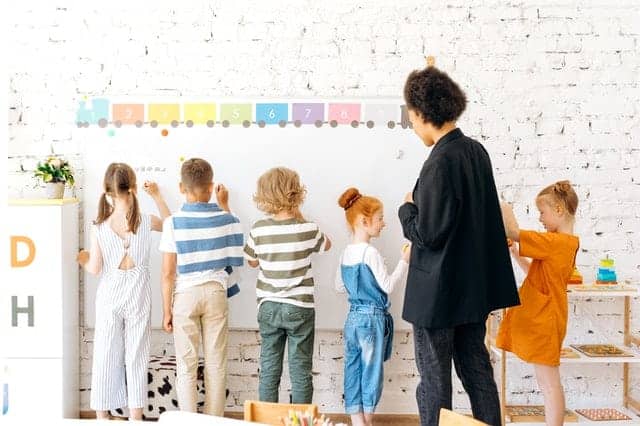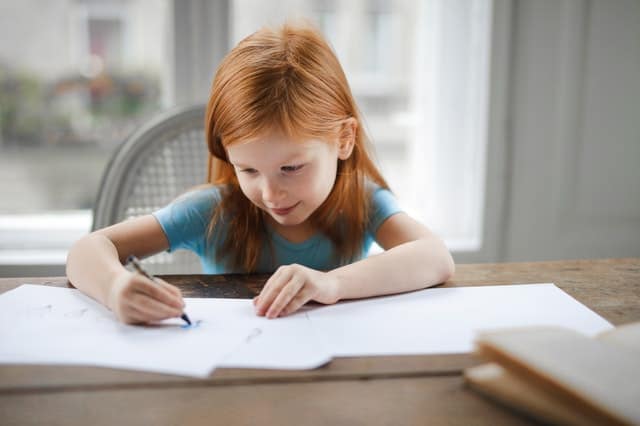Most adults understand that gratitude is more than saying thank you when receiving a gift or compliment. Gratitude is an attitude of the heart.
Some parents may ask, “What is gratitude for kids?” It’s one thing to teach children to say thank you–express gratitude–and it’s another to live with an attitude of gratitude.
This article will discuss how to teach gratitude to kids. We’ll also share some great gratitude activities for kids.
What Is Gratitude For Kids?
When some of our team members were on-site at a school just before the pandemic hit, they discussed gratitude with a group of children. One child said, “Gratitude means you’re happy when your parents give you something.” The team smiled at the child and used their response to discuss further.
Webster’s dictionary defines gratitude as “A feeling of appreciation or thanks.” Children experience feelings–or attitudes–of thanks many times throughout their days. When a teacher calls on them in class–thus expressing an interest in their thoughts–or when a classmate compliments them. Other instances can include when someone lets them borrow a pencil, or someone else plays nicely with them at recess.
All these examples help children connect the idea of gratitude to the feeling of thanks.
When we talk about what gratitude is for kids, we need to remember not to focus on material goods but on the actions of others and whatever provision we have in our lives.
A child in one of our online sessions explained gratitude this way, “It is how I felt when my mom smiled at me when I was nice to my sister.” At 9-years old, this child expressed a social-emotional response that led to them feeling warm and accepted.
Another student in high school described gratitude as “Recognizing the fact that someone else truly sees me.” This response indicates a more developed understanding of the complex nature of feelings and interpersonal relationships. It also describes an internal response to an outward stimulus.
We share these examples, in particular, to highlight the fact that how you explain gratitude to a child will vary in terms of their ages. Fortunately, most children have experienced this and therefore, can relate to definitions of the words and actions that exemplify what it feels like internally.
The children’s entertainment organization PBS reminds us that children imitate the adults in their lives. To that end, we can show children what gratitude looks like when we consistently thank others for both big and small acts of kindness.
PBS writes, “Encourage your child to follow suit. When you write a thank you note to someone they know, let them add a picture or dictate a few words. As they get older, encourage them to write their own thank you cards or make thank you gifts for people who have touched their lives, such as teachers, coaches, or community helpers.” Showing gratitude in front of your children and then involving them in expressions of appreciation helps them make the connections between what gratitude looks like and how it feels.
There are several activities teachers can use in their classrooms, and parents can use at home to teach gratitude to kids.
Gratitude Activities for Kids
These activities can bring gratitude to life and help kids celebrate the positive feelings associated with such a fantastic attitude!
Each of the following gratitude activities for kids can be modified to your child’s level of development.
Create a Gratitude Jar
All you need to create a gratitude jar is a large clear container, a stack of sticky notes, and a pen (or brightly colored markers if you’re feeling creative).
Each evening, invite everyone in the family to write or draw something they are grateful for. They can depict something that happened that day or a mainstay in their lives, such as their pet, a favorite food, or a special friend. On Fridays, read the gratitude notes as a family and celebrate each one with smiles, applause, etc.
Create a Gratitude Vision Board

Vision boards are an excellent way for children to keep the positive aspects of their lives in front of them so when they’re feeling down, isolated, or sad, they can quickly reference their vision boards and remind themselves how much they have to be grateful for.
Gather magazines, construction paper, stickers, and any other media to help children describe what it means to be grateful. Have them create a list of things, people, or places for which they are thankful. Then have them fill their vision boards with words or photos that represent the items on their list.
Gratitude Prompts
Gratitude prompts are a great way to help children begin a consistent gratitude practice. All they need to do is consider each prompt and then fill in the blanks. The goal is to identify at least three things in each category they are thankful for. Then have them share.
The prompts can include:
I’m grateful for three things I hear:
I’m grateful for three things I see:
I’m grateful for three things I smell:
I’m grateful for three things I touch/feel:
I’m grateful for these three things I taste:
I’m grateful for these three blue things:
I’m grateful for these three animals/birds:
I’m grateful for these three friends:
I’m grateful for these three teachers:
I’m grateful for these three family members:
I’m grateful for these three things in my home:
Etc.
Writing Thank You Notes

Have children choose three people in their lives who have treated them with kindness or consistently made them feel seen and heard. Then invite them to write a thank you note to each of the people they’ve chosen. The notes should include three ways in which the person made them feel loved or cared for and three ways in which they learned something about gratitude due to the person’s kindness.
Ask the students to send these notes via email, mail, or in-person with their parents’ help.
Teaching gratitude to kids helps them recognize what thankfulness feels like and looks like, as well as how it can improve the lives of those who give it and receive it. Gratitude is a powerful tool in teaching children that they can recognize beauty and kindness in the world and offer it to others.
Soul Shoppe’s mission is to create safe environments that bring forth a culture of compassion, connection, and curiosity. Our innovative, interactive, and highly effective social emotional learning programs give parents, homeschoolers, teachers, and corporations important lifelong skills. Our online programs include the Peacemakers Program, Respecting Differences, Tools of the Heart, and more.
For more information on how we can help you, contact us today.
You May Also Like:
Teaching Emotional Intelligence


